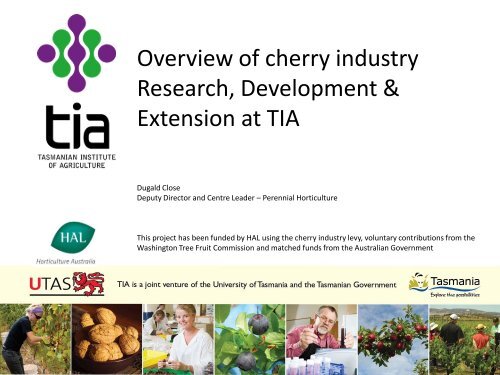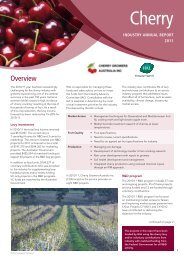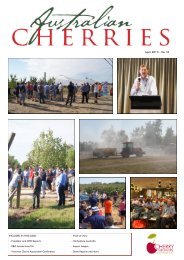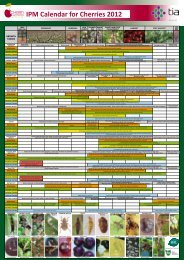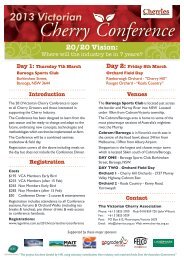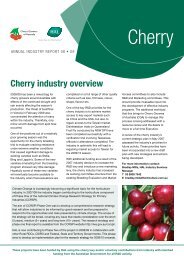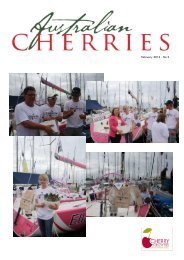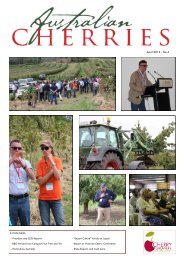Overview of cherry industry Research, Development & Extension at ...
Overview of cherry industry Research, Development & Extension at ...
Overview of cherry industry Research, Development & Extension at ...
- No tags were found...
Create successful ePaper yourself
Turn your PDF publications into a flip-book with our unique Google optimized e-Paper software.
<strong>Overview</strong> <strong>of</strong> <strong>cherry</strong> <strong>industry</strong><strong>Research</strong>, <strong>Development</strong> &<strong>Extension</strong> <strong>at</strong> TIADugald CloseDeputy Director and Centre Leader – Perennial HorticultureThis project has been funded by HAL using the <strong>cherry</strong> <strong>industry</strong> levy, voluntary contributions from theWashington Tree Fruit Commission and m<strong>at</strong>ched funds from the Australian Government
Current/recently completed projects:1. Optimising <strong>cherry</strong> fruit set, crop load and fruit nutrition and size (2010-2012)‣Dugald Close, Sally Bound, M<strong>at</strong>t Whiting*, Erik Smith*, Nigel Swart, Eric Mertes, Bob Dambergs, Eva Aertse, AudreyQuentin, Penny Measham, Lieke Hennen2. Improving marketable yield <strong>of</strong> premium quality cherries (2009-2012)‣Penny Measham, Sally Bound3. Effect <strong>of</strong> <strong>cherry</strong> variety and fruit density on fruit rot (2012)‣Penny Measham, Karen Barry, K<strong>at</strong>hy Evans4. Sustaining production in marginal clim<strong>at</strong>es (2012)‣Penny Measham, Audrey Quentin5. <strong>Extension</strong> contributions to the CGA newsletter, factsheets, <strong>cherry</strong> export manual, IPMposter (Ongoing)‣Penny DomeneyNew projects1. Reducing the impact <strong>of</strong> l<strong>at</strong>e season rainfall (2012-2015)‣ Penny Measham, Sally Bound, Karen Barry, Penny Domeney2. Optimising <strong>cherry</strong> fruit set, crop load and fruit nutrition and size – Phase 2 (2012-2015)‣ Dugald Close, Sally Bound, M<strong>at</strong>t Whiting*, Erik Smith*, Nigel Swart, Jo Jones, Eric Mertes, Bob Dambergs3. Improving fruit quality and consistency in cherries through maximised nutrientavailability (2012-2017)‣ Sally Bound, Penny Domeney, Penny Measham
%Fruit seti. Variability in flowering time, fruit set and fruit quality? (concluded in2010/11 season)• Fruit set was 35% Simone, 37% Van and 38% Sweetheart, around 75% <strong>of</strong> which was setover a 4-day window, not increased by hand pollin<strong>at</strong>ion.• Fruit from earlier bloom d<strong>at</strong>e was not <strong>of</strong> higher quality than l<strong>at</strong>er bloom d<strong>at</strong>e fruit, incontrast to some results from Washington St<strong>at</strong>e (where crop loads were much higher)35.030.025.020.015.010.05.00.030-Sep'Sweetheart' Distribution <strong>of</strong>Fruit/Total Fruit as % by D<strong>at</strong>e0.2 0.3 1.4 4.9 18.52-Oct4-Oct28.76-Oct8.520.28-OctBloom D<strong>at</strong>e5.7 5.7 2.9 2.2 0.7 0.2 0.110-Oct12-Oct14-Oct
Fruit setii. Can we manipul<strong>at</strong>e fruit set with PGRs?2010/11 season results promising but inconclusive (adverse rainfall)2011/12 season (Kordia [results shown below] and Regina <strong>at</strong> CherriesTasmania, Old Beach):Tre<strong>at</strong>ments: 1. untre<strong>at</strong>ed control2. 4g Retain / 5L w<strong>at</strong>er @ 30% bloom3. 4g Retain / 5L w<strong>at</strong>er @ 80% bloom4. 4g Retain / 5L w<strong>at</strong>er @ 30% & 80% bloom5. 6g Retain / 5L w<strong>at</strong>er @ 30% bloom6. 6g Retain / 5L w<strong>at</strong>er @ 80% bloom7. 6g Retain / 5L w<strong>at</strong>er @ 30% & 80% bloomHigher fruit set, higher fruit set per spur (and less cracked fruit)!
Fruit setii. Can we manipul<strong>at</strong>e fruit set with PGRs?But there are impacts on fruit quality• Higher set comes withsmaller fruit• Firmness gre<strong>at</strong>er with retain, with 6 g/L and stem pull force impacted by double applic<strong>at</strong>ion
Fruit setiii. Can we manipul<strong>at</strong>e fruit set using targeted trunk or branch girdling?Tre<strong>at</strong>ments: Kordia and Regina (results shown below) <strong>at</strong> Cherries Tasmania, OldBeach, ± Trunk girdle (pre-bloom), Limb girdle: nil, pre-bloomResults (limb girdling results inconclusive):• No effects on fruit set• But positive effects on yield and fruit size (no neg<strong>at</strong>ive impact on sugar)• Neg<strong>at</strong>ive impact on fruit dry m<strong>at</strong>ter content• Positive effects on firmnessand stem-pull
Crop load managementi. Wh<strong>at</strong> is the optimum crop load and post-bloom thinning for yield/size?Results (Van <strong>at</strong> Reids Fruit - same trends inSweetheart):• 14-33 T/Ha• Fruit weight and diameter lower <strong>at</strong> highcrop load• Sugar, acid and firmness lower <strong>at</strong> highercrop load• Cracking 59% <strong>at</strong> low crop load comparedto 18% <strong>at</strong> high – a challenge!7060504030201001 bud/spur2 buds/spur4 buds/spur
Crop load managementii. When is the best time to thin to the targets?2010/11 results (using Van):• Fruit from thinning <strong>at</strong> dormant or FB larger• % Cracking similar• Fruit from 4 and 6 wAFB less colour• Sugar, TA and firmness similar60Audrey and Hawa thinningSweetheart 6 wAFB50403020100DormantFull bloom (FB)2 wAFB4 wAFB6 wAFB
Crop load managementiii. Which buds have the gre<strong>at</strong>est quality potential?Methods:• Simone, Kordia and Van• Apical and basal buds labelled or• Spurs thinned to apical or basal bud onlyAbove: apical and basalbuds labelledRight: ExperimentalResults:tree• Little differences – <strong>industry</strong> advice to discontinue this line <strong>of</strong> research35302520151050ApicalBasal
Summary:Fruit set:i. Timing <strong>of</strong> flowering did not affect qualityii. Applic<strong>at</strong>ion <strong>of</strong> retain <strong>at</strong> 30 or 80% bloom increased fruit set and firmnessbut decreased fruit size <strong>of</strong> Kordiaiii. Trunk girdling increased Regina yield, fruit size, firmness and stem pullCrop load management:i. At high crop load (above 20 T/ha in Van) fruit size, sugar, acid and firmnessdecreasedii. Thinning buds or thinning <strong>at</strong> full bloom leads to increased fruit size rel<strong>at</strong>iveto l<strong>at</strong>er thinningiii. No difference was found in fruit quality from apical or basal buds
Fruit nutrient m<strong>at</strong>rixi. Wh<strong>at</strong> are the nutritional characteristics <strong>of</strong> high-quality fruit?ii. Can we develop a nutrient m<strong>at</strong>rix for fruit quality?•Fruit from 7 orchards <strong>of</strong> wide range <strong>of</strong> nutrient content•Postharvest quality:• Sugar levels steady• Acid gradually decreased with time• Firmness gradually increased with time (due to dehydr<strong>at</strong>ion)• Given the linear responses can we predict post-harvest qualitybased on fruit quality <strong>at</strong> harvest?
AUAUAUQuality post-harvest• Colour generally increases withphysiological ripening then stays constant• Anthocyanin does not correl<strong>at</strong>e withcolour indic<strong>at</strong>ing th<strong>at</strong> increases in colourdue to oxid<strong>at</strong>ion <strong>of</strong> pigments? i.e. ageneral ‘blackening’ <strong>of</strong> tissues• But HPLC indic<strong>at</strong>es th<strong>at</strong> this is not due tooxid<strong>at</strong>ion <strong>of</strong> anthocyanin pigments, orchanges in general phenolic pr<strong>of</strong>iles –oxid<strong>at</strong>ion <strong>of</strong> chlorophyll and carotenoidpigments?5% formicCaroline <strong>cherry</strong> anthocyanins D40-8 (1) PDA Ch2 497nm@2.4nm-MBF6.15;311Range: 3e-3Area2.0e-31.0e-35.776.930.07135.50 6.00 6.50 7.00 7.50 8.00 8.50Caroline <strong>cherry</strong> anthocyanins D0-8 (1) PDA Ch2 497nm@2.4nm-MBF6.13;291Range: 2e-32.0e-3Area1.0e-35.736.930.07155.50 6.00 6.50 7.00 7.50 8.00 8.50Caroline <strong>cherry</strong> anthocyanins D0-7 (1) PDA Ch2 497nm@2.4nm-MBF6.17;1641.0e-35.0e-40.07.331187.351597.37116Range: 1e-3Area5.786.955.376146Time5.50 6.00 6.50 7.00 7.50 8.00 8.506.565.554.543.530.60.50.40.30.20.10ColourAlrightKileMikeMagraNicReidHoward0 10 20 30 40 50AnthocyaninAlrightKileMikeMagraNicReidHoward0 10 20 30 40 50
Stem pull forceQuality post-harvest• Stem pull force gradually decreases with time since harvest (excellentpotential for prediction given straight-line rel<strong>at</strong>ionship)5.55Stem pull force4.543.53HowardJonesKileMikeNic2.5220 30 40 50Days post harvest
ColourColourColourCorrel<strong>at</strong>ions <strong>of</strong> nutrition with quality <strong>at</strong> harvest• Significant correl<strong>at</strong>ions <strong>of</strong> decreased fruitcolour with increased fruit nitrogen, zincand manganese concentr<strong>at</strong>ions6.565.554.5y = -0.0127x + 6.958R² = 0.2896.5• No other significant correl<strong>at</strong>ions <strong>of</strong> anynutrients with any <strong>of</strong> the measuredquality <strong>at</strong>tributes <strong>at</strong> harvest43.53100 110 120 130 140 150 160 170 180Nitrogen concentr<strong>at</strong>ion6.565.55y = -15.552x + 6.4271R² = 0.590265.55y = -4.767x + 5.6527R² = 0.15854.543.530.000 0.020 0.040 0.060 0.080 0.100 0.120 0.140 0.160Zinc concentr<strong>at</strong>ion4.543.530 0.05 0.1 0.15 0.2 0.25Manganese concentr<strong>at</strong>ion
2011/12 season:Can we manipul<strong>at</strong>e fruit nutrition through fertig<strong>at</strong>ion and will this benefitquality post-harvest?• Yes – we can manipul<strong>at</strong>e fruit nitrogen content• Yes - increased fruit nitrogen content correl<strong>at</strong>es with decreased firmness <strong>at</strong>the upper end <strong>of</strong> nitrogen applic<strong>at</strong>ionsabaabb
Manganese (ppm)Zinc (ppm)2011/12 season:Can we manipul<strong>at</strong>e fruit nutrition through foliar sprays and will this benefitquality post-harvest?• Yes – we can manipul<strong>at</strong>e fruit manganese and zinc, (but not with Zm 2 )• No – we cannot manipul<strong>at</strong>e fruit calcium• No impacts on quality postharvest181614121086420302521bcabcGroveabcbabWoodstockbbCaMnZnZm2Control2015aCaMnZn105bbbbbbbbZm2Control0GroveWoodstock
Summary:• There was large vari<strong>at</strong>ion between orchards in fruit nutritionand quality <strong>at</strong> harvest• As previously shown firmness (Guss flesh texture) increased(due to dehydr<strong>at</strong>ion = decreased perception <strong>of</strong> firmness tothe consumer?), sugar was constant and acids and stem pullforce decreased linearly with time since harvest• At harvest Colour decreased with increasing fruit nitrogen,zinc and manganese concentr<strong>at</strong>ion• High N fruit = s<strong>of</strong>t fruit post-harvest• Foliar zinc and manganese sprays increase fruit content <strong>of</strong>these nutrients, but there was no positive effect post-harvest
Improving marketable yield <strong>of</strong>premium quality cherriesPenny Measham and Sally BoundThree year project 2009-2012Aims to Improve marketable yield bya) Reducing crackingb) Maintaining qualityFinal season results support previous trends;Str<strong>at</strong>egies to reduce cracking include sprays, irrig<strong>at</strong>ionregimes, crop load and pruning(Slides provided by Penny Measham)
Sprays reduced cracking by up to 50% in 2010/11 and 33% in2011/12Majority <strong>of</strong> reductions in cuticular cracks (apical and stem end)Quality parameters not adversely affected
Maintaining higher soil moistures reduced cracking by upto 33% in 2011/12Reduced cracking index values in all yearsMajority <strong>of</strong> reductions in side cracksQuality parameters not adversely affected
Crop load influenced cracking in all yearsMeasham, PF and Bound, SA and Gracie, AJ and Wilson, SJ, ‘Crop load manipul<strong>at</strong>ion and fruit cracking insweet <strong>cherry</strong> (Prunus avium L.)’, Advances in Horticultural Science, 26 (1) pp. 25-31.Pruning dependant on fruit m<strong>at</strong>urity, and timing (rainfall)• During rainfall, reduced cracking• Just before rainfall, no impact• Within three weeks before harvest, improved quality• At Stage II, reduced quality
Effect <strong>of</strong> <strong>cherry</strong> variety and fruitdensity on fruit rotPenny Measham, Karen Barry, K<strong>at</strong>herine EvansOne year project 2011/2012Aims;• Liter<strong>at</strong>ure review <strong>of</strong> brown rot in cherries (andmanagement options)• Investig<strong>at</strong>e effect <strong>of</strong> crop load and fruit quality on rotincidence• Investig<strong>at</strong>e incidence <strong>of</strong> l<strong>at</strong>ent infection over time• Investig<strong>at</strong>e rel<strong>at</strong>ionship <strong>of</strong> fruit phenolic chemistry withl<strong>at</strong>ent infectionChemical analyses underway
Sustaining production in marginalclim<strong>at</strong>esPenny Measham, Audrey QuentinOne year project 2012/2013Aims;• Quantify chill requirement <strong>of</strong> two varieties• Investig<strong>at</strong>e rel<strong>at</strong>ionship between chill conditions andbud burst uniformity• Investig<strong>at</strong>e rel<strong>at</strong>ionship between bud carbohydr<strong>at</strong>elevels (pruning) and bud burst uniformity• Investig<strong>at</strong>e response to chill requirements <strong>of</strong> buds withdifferent carbohydr<strong>at</strong>e levelsTrials commencing
Acknowledgements• Industry for support <strong>of</strong> our research• Growers for generous don<strong>at</strong>ion <strong>of</strong> fruit and for discussions:Pip Alright, Garth Friday, Howard Hansen, Nic Hansen, Ross Kile, NickNorske, Mike Oakford, Oak Enterprises (Grove <strong>Research</strong> St<strong>at</strong>ion), Tim Reid,John Woodwood• FGT honours scholarships to Eric Mertes and Nick MacNair• Peter Morrison and Andrew Hall for discussions on fertig<strong>at</strong>ion and fruitnutrition• The projects were funded by HAL using the <strong>cherry</strong> <strong>industry</strong> levy, voluntarycontribution from the Washington Tree Fruit Commission and m<strong>at</strong>ched fundsfrom the Australian Government• A gre<strong>at</strong> team <strong>of</strong> researchers


